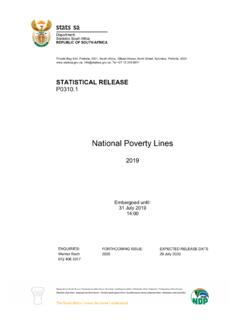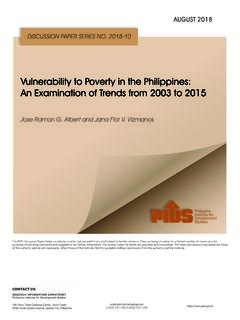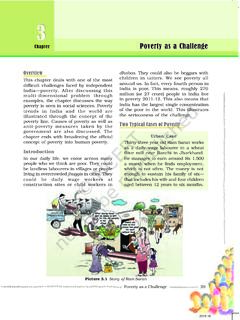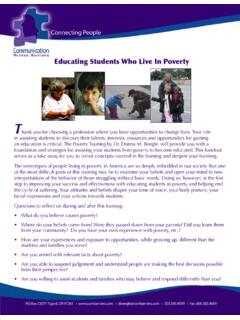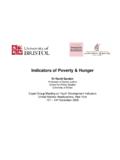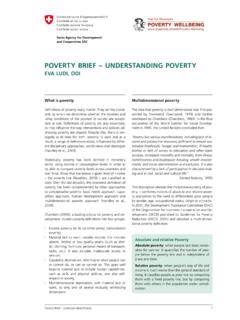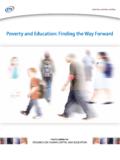Transcription of The Impact of Poverty on African American Children in the ...
1 Forum on Public Policy The Impact of Poverty on African American Children in the Child Welfare and Juvenile Justice Systems Rudolph Alexander, Jr., Professor, College of Social Work, The Ohio State University Abstract Poverty among individuals is an enduring condition in almost all societies.
2 The responses by governments to Poverty , however, have varied. In the United States, President Lyndon Johnson sought to address Poverty through the creation of the Great Society programs in the 1960s. In effect, he declared a War on Poverty . Later, especially during the Republicans takeover of the government in the 1980s, another initiative used to address Poverty was to use increasingly American social institutions volunteer organizations and correctional institutions. President Reagan declared a War on Drugs.
3 Simply, prisons, both adult and juvenile, became a primary tool for controlling people in Poverty . America went from a War on Poverty to a War on Drugs, ensnaring many African Americans within the criminal justice system with an ensuing Impact on African American Children . While the child welfare system has long taken poor Children out of their homes, the juvenile justice system has done so too. Often, family courts handle both neglected Children and delinquent or unruly Children , and often poor African American Children are disproportionately affected in both the child welfare and juvenile justice systems.
4 Black s theory of law is provided to aid in the understanding of African American Children in both systems. In sum, this paper discusses the Impact of Poverty on African American Children in both the child welfare and juvenile justice systems. Introduction Being poor and living in Poverty have a number of negative outcomes (Howell & McFeeters, 2008; O Regan & Quigley, 1996). In the early 1900s, penologists noted that prisons were full of individuals who were poor, were from the lower class, and were immigrants (Allen, Latessa, & Ponder, 2010).
5 Also, professionals have noted that Poverty was associated with other human needs and exacerbated other problems (Aizer, 2008; Ortiz & Briggs, 2003), such as infant mortality and dropping out of school (Alexander, 2010). People in Poverty suffer most from medical illnesses and poor health, such as diabetes and its effects that cause blindness, amputations, and death (Alexander, 2010). Stobbe (2010) reported that HIV has been now linked to Poverty . Though Poverty is associated with medical problems, there are social consequences for Poverty .
6 For instance, two parents on public assistance voluntarily requested a dependency petition because they were unable to financially and emotionally care for their two Children . As a consequence, the two Children were put in foster care (In the Matter of the Welfare of M. A., and J. A., 1987). With respect to Children living in Poverty , they are likely to be minorities and African Americans (Wight, Chau, & Aratani, 2010). Ward 8 within the Nation s capital, Washington DC, has a Poverty rate of 40 percent and an employment rate of percent (Robiinson, 2010).
7 According to 2009 data derived from the U. S. Population Survey, Annual Social and Economic Supplement, 14 million Children live in families who have incomes below the Poverty level (Wight, Chau, & Aratani, 2010). The Poverty level in 2009 was $22,050 for a family of four (Cauthen & Fass, 2008). Researchers found that of the 88 counties in Ohio, living below 1 Forum on Public Policy Poverty was associated with Children living apart from their families (Curtis & Alexander, unpublished manuscript).
8 In the 1960s President Johnson proposed the Great Society programs with the goal to eliminate Poverty . It created the Office of Economic Opportunity and other programs to address Poverty . This strategy was called the War on Poverty . Later in the 1980s when the Republicans took control of the legislative branch, they revamped programs such as, Aid to Families with Dependent Children (AFDC) into the Temporary Assistance Needy Families (TANF) to address Poverty and to drive parents into low income jobs.
9 Moreover, the Republicans declared a War on Drugs too. The results of these policy changes were increased use of private and voluntary organizations to help poor families, less governmental aid for poor people, and increased use of social control institutions to manage the poor. African American Children have the most Poverty , representing 35 percent (Moore, Redd, Burkauser, Mbwana, & Collins, (2009). A study of African Americans living below Poverty showed as the more Poverty in a census tract, the more likely that Children were not living at home (Curtis & Alexander, 2010).)
10 These researchers, Curtis and Alexander, speculated that these African American Children not living at home were either in the child welfare system and juvenile justice system. African American Children make up a very large portion of the Children in both the foster care and juvenile justice systems. African Americans make up the largest population in many youth facilities (Arkansas Department of Youth Services, 2009; Georgia Department of Juvenile Justice, 2010; Louisiana Office of Juvenile Justice, 2009; New York Department of Juvenile Justice, 2009; Ohio Department of Youth Services, 2010).










